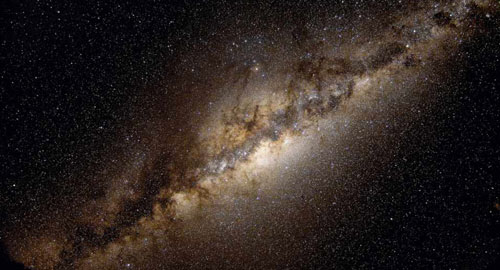
Every so often, the fossil record shows, ecological disasters wipe large numbers of species off the face of Earth. These mass extinctions occur roughly every 26 million to 30 million years—about the same interval at which our solar system passes through the plane of the Milky Way. Putting two and two together, some researchers have proposed that clouds of dust and gas in the galactic plane might disrupt the orbits of far-flung comets and trigger planet-smacking collisions. A new study suggests an additional culprit may lie behind those times of woe: dark matter.
Some of Earth’s past mass extinctions have been caused by the impacts of extraterrestrial objects, such as the asteroid that struck near Mexico’s Yucatán Peninsula and wiped out the dinosaurs about 66 million years ago. Others have occurred during extended periods of geological disruption that include region-smothering volcanic eruptions. Both kinds of catastrophes seem to occur on a cycle of about 30 million years, notes Michael Rampino, a geoscientist at New York University in New York City. “It’s always been a mystery as to how extraterrestrial impacts could cause these long-lived geological effects,” he says. But invisible dark matter, he proposes, could trigger both extraterrestrial impacts and geological upheavals in one fell swoop.
Scientists still don’t know what dark matter is, but its gravitational pull on other objects in space shows that there’s a lot of it out there. Researchers estimate that in the plane of the galaxy, each square light-year contains about one solar mass of dark matter. Like the clouds of dust and gas that astronomers can see, clouds of dark matter may be perturbing the orbits of distant comets, causing them to fall into the inner solar system where they can strike Earth.
But those clouds could directly affect Earth as well, Rampino says. As the solar system passes through this purported haze of particles clogging the galactic plane, some get trapped by Earth’s gravity, Rampino suggests. These particles orbit Earth’s core and eventually fall to the center of the planet, where they interact with normal matter or one another, releasing energy that gets transformed into heat.
In the time it takes for the solar system to cross the galactic plane, interactions with dark matter could raise the temperature of Earth’s core by hundreds of degrees Celsius, Rampino reported online this week in the Monthly Notices of the Royal Astronomical Society. Then, over millions of years, that heat could be carried to Earth’s surface via massive plumes of hot buoyant rock that, in turn, create volcanic hot spots or slowly rip apart continents—possibly altering global climate or making huge swaths of the planet so inhospitable that millions of species perish.
The idea that dark matter might cause both extraterrestrial impacts and geological upheavals “is intriguing,” says Dennis Kent, a geophysicist at the Lamont-Doherty Earth Observatory in Palisades, New York. “One of those sources of environmental disruption might be tolerable,” he notes, but together they might pack a one-two punch that is too much for many ecosystems to bear. Indeed, he adds, some rather large impacts that weren’t accompanied by widespread geological devastation—such as an object that slammed into what is now the Chesapeake Bay nearly 35 million years ago, leaving a now-buried crater—don’t seem to have caused significant ecological damage.
sciencemag

